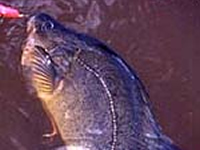Fish Senses

This golden perch's lateral line is clearly visible down its flank.
There is no doubt that a fish can see, smell, taste and perhaps hear but how do these senses work.
"The brain of a fish is small and the nervous system mainly controls reflex behavioural responses which result from sensory stimulation. The eye of a fish is similar in some ways to a mammalian eye. However the lens is spherical, and the cornea is relatively flat and the pupil has little power of contraction.
Most fish have monocular vision. Focussing is carried out by adjusting the position of the lens relative to the retina rather than by changing the shape of the lens. However because of the scattering of light rays in water, a clear view is difficult anyway and so contrast enhancement and perception of movement is more important. Some fish species can also see in colour.
Taste organs are present in the skin layer of the mouth, lips, pharynx and in some fish on the surface of the head or on barbels.
Fish can smell and have paired nostrils on each side of the snout which are blind sacs lined with lamellar sensory epithelium and connected by the olfactory nerve to lobes in the brain.
They have an inner ear but it is not connected to the outside of the body. The function of the inner ear is more concerned with monitoring the fishes movement and gravitational position.
Fish also have a lateral-line system which consist of long, narrow fluid-filled tubes extending from the tail to the head. Its function is thought to be as a reception of localised disturbances such as small currents, vibrations and irregular small displacements of surrounding water. Temperature perception organs and direct touch receptors may probably also be present in the skin but little is known about them".
These senses provide all that is necessary for a fish to become aware of the careless angler but also enable it to be taken in by the fresh bait, well presented fly or sparkling lure.
From a series of lectures to Veterinarians at University of Sydney (1979) on Management and Diseases of Hatchery Fish, given by L.D.Ashburner. Fisheries Scientist. Snobs Creek Freshwater Research Station and Hatchery, Alexandra. Victoria.
